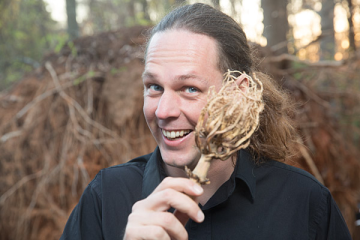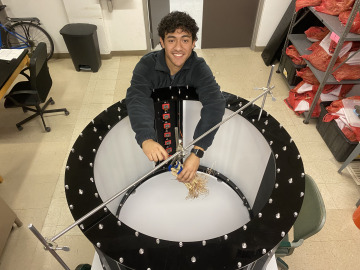New plant science lab examines how root architecture can shape the future
During his first year at UArizona, Alexander Bucksch formed a diverse lab group who connects root shape with agricultural success using state-of-the-art imaging technology.
A traditional 3D imaging device used to scan root structures in Alexander Bucksch's lab. New technology developing in his lab aims to enable 3D scans to be taken in the field.
Plant roots, to some, look like a messy ball of tangled hair. To others, like Alexander Bucksch, these roots make intricate patterns that could help solve agriculture’s biggest challenges.

Alexander Bucksch recently joined UArizona's School of Plant Sciences as an associate professor who researches plant root architecture.
Bucksch is an associate professor in UArizona's School of Plant Sciences who uses two-dimensional and three-dimensional imaging technology to understand why plant roots have varying success in taking up resources such as water or nitrogen from the soil.
Bucksch moved to the University of Arizona in 2023 from the University of Georgia. Amongst other prestigious awards, he earned an NSF Career Grant that now funds various projects in his computational plant science lab at UArizona.
“The NSF grant is the center of all the research that happens in my lab,” Bucksch said. “It’s about the development of tools to quantify the variation of root architectures and their functions in a field population.”
Roots taking shape
The shape of the root system matters because certain soil resources, like nitrogen, phosphorus and water, are all different in soil depth, concentrations and forms ranging from stationary to highly mobile. Depending on how far down or how wide the roots reach, along with other root variations, the plant will be more successful in exploiting and absorbing certain nutrients over others.
“Over the years, we found out that plants have several architectures in a population and each of these root architectures has a specific function — they are actually specialists in the uptake of certain nutrients,” Bucksch said. “Now, we are working to decipher if we can use the specialization to mitigate the effects of stresses like drought, for example.”
New data Bucksch presented at this year’s Desert Ag Research Symposium showed that root systems specialized in the uptake of one soil resource could share their resources with plants that are not as successful in a given environment. Bucksch said that if they can develop the tools to harness these plant interactions, agriculture professionals can use them to produce higher yields.
A technology-driven approach
The system of classifying root architectures starts with digitally scanning their research subjects to further examine shapes and their biological significance. While this process is usually done by bringing root structures to larger industrial scanners, Bucksch’s lab is developing a new, smaller scanner that will be portable.
“The new scanner, developed by our post-doc Suxing Liu, dramatically shortens our scanning times so we are able to collect much more data,” said Will LaVoy, a School of Plant Sciences doctoral student and member of Bucksch’s lab studying 3D interactions between roots. “Moving forward, this will also allow us to scan roots in the field, avoiding any of the damage and complications that come with storing roots for analysis in the lab.”

Biosystems engineering undergraduate student Ruben Pena maintains technology in Alexander Bucksch's lab, such as the new root imaging device developed by Suxing Liu.
To accomplish complicated feats such as analyzing a multitude of data points and developing new pieces of technology, Bucksch spent his first year at UArizona bringing together a lab group with skill sets reaching beyond plant science.
One of these lab members is Ruben Pena, a sophomore majoring in biosystems engineering who is one of the engineers in the group and oversees the maintenance of technology the lab uses, such as the new 3D scanner.
“I’ve always been interested in agriculture and working with biosystems to efficiently grow plants,” Ruben said. “This lab has a lot of people with their own different projects, but we come together to focus on one goal and that is really progressing the lab.”
The future of growing
Bucksch and his group of researchers are continuously developing new research projects and tools to investigate roots on scales from entire root systems down to microscopic details called root hairs. These new tools allow for observations that provide plant breeders with the input needed to develop crop varieties that succeed in harsh environments. However, Bucksch envisions applications beyond agriculture as well.
“We are now at a stage we want to scale our research, not just in the number and type of plants, but the areas of research, too,” Bucksch said. “We want to explore if we can use our research to enhance ecosystem services of plants that capture CO2 from the air or cool the environment and generally help preserve life in the face of adverse climate change effects.”
